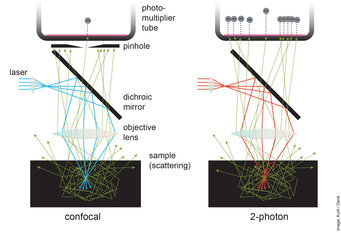The Two-Photon Fluorescence Microscope

The two-photon fluorescence microscope, developed by Winfried Denk and his colleagues Jim Stricker and Watt Webb in the late 1980s [1], is today an integral part of many biomedical research laboratories. The revolutionary thing about this microscope: It enabled, for the first time, the observation of cells with astonishing clarity, comparatively deep in living tissue and over longer periods of time.
The microscope’s base is a laser that emits ultrashort, intense laser light pulses with a very high photon density. If two of these photon pulses arrive simultaneously at a fluorescent molecule, they can excite it. This excitation is very focused and takes place only in the focal area of the laser beam. As a result, the surrounding tissue is protected from the high-energetic light, preventing phototoxicity. To excite fluorescent molecules, the two-photon microscopy uses light in the deep-red or infrared range.
Fluorescence
A molecule fluoresces, when it absorbs an incoming photon and emits, as a result, another photon of a different color. In classical fluorescence microscopy, before the invention of the two-photon microscope, this excitation occurred through exactly one photon. The high energetic light of short wavelengths (often blue or ultraviolet) excites one electron of the fluorescent molecule. The electron remains at a higher energy level for a few nanoseconds, before it falls back to its original position. In the process, a new, longer-wavelength and thus lower-energy photon is emitted. For example, green fluorescence results from the excitation with blue light.
At very high light intensity, such as from a pulsed laser beam, a fluorescent molecule can occasionally absorb two photons. The photon emitted as a result then contains (almost) twice the energy. In this way only is it possible to cause emission of (green) light from a molecule when exciting it with low-energy red light. Outside the focal point, the intensity of the red light is too low to cause the two-photon effect, thus preventing the tissue from bleaching. This enables investigations deep in the tissue and over longer periods of time.
Gaining deep insights
Traditional fluorescence microscopy can be employed only to investigate thin tissue slices, i.e. dead material. In thicker tissue, scattering and refraction of light by surrounding structures prevents a clear view into deeper layers, and investigations are only possible up to a depth of 50-80 µm. By contrast, the highly focused light pulses of two-photon microscopy allow the examination of objects that are up to 1000 µm deep within living tissue.
A main field of application of two-photon microscopy is neurobiology. The cells in the brain and nervous system are densely interconnected, scattering light strongly. Therefore, the invention of two-photon microscopy has been able to provide in this research field especially numerous and completely new insights – showing interactions under intact tissue conditions and allowing conclusions about the behavior of nerve cells under physiological conditions.
